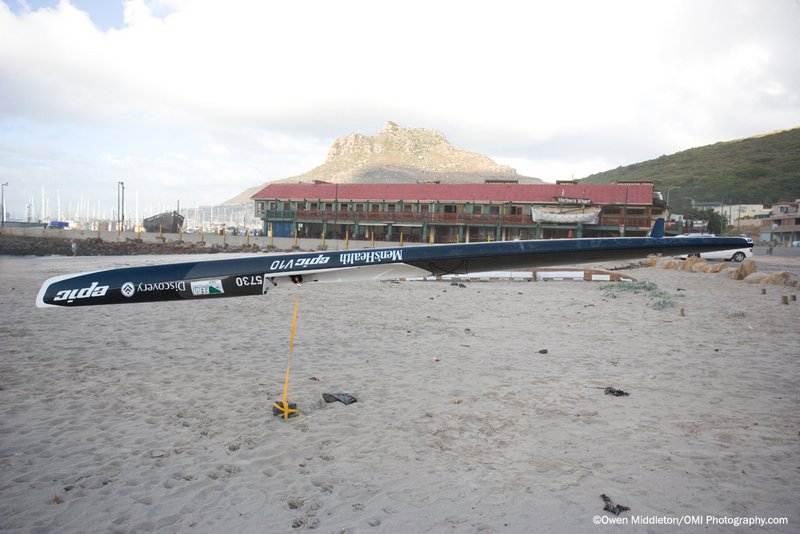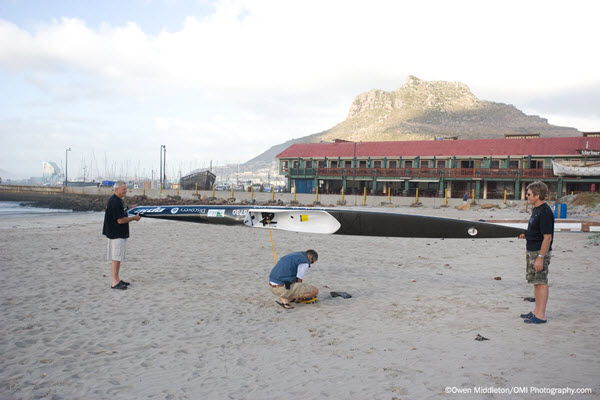THE EPIC ULTRA, ULTRA ELITE
 Epic V10 Ultra, Ultra Elite
Credits: Owen Middleton
Epic V10 Ultra, Ultra Elite
Credits: Owen Middleton
[Editor: Dale Lippstreu is well known for tinkering with his skis - and many of his creations (rudders, rudder winglets, cockpit bulkheads, etc) have featured on surfski.info. Now he's made what is arguably the most extreme modification yet - to make his V10 Elite into an Ultra, Ultra Elite...]
Click here for a larger version of the image.
Hydrogen Ski
I have had my Epic Ultra Elite for just over a year and continue to enjoy the weight and performance so I thought I would try taking it to a new level by reducing the weight still further. The simple solution was to evacuate the air and replace it with hydrogen. The end result is that my ski now has a negative weight of minus 0.5kg - yes it floats on air just like a kiddie's party balloon!
[Editor: Technically Speaking...
Filling the ski was simplicity itself - because the hydrogen is lighter than air, all that was necessary was to turn the ski upside down and bleed the hydrogen in at a slow rate through the bung hole. The displaced air is heavier than the hydrogen and flows out as the hydrogen flows in.
Obviously the bung then has to be sealed before turning the ski right way up again.
The only expensive part of the exercise was the purchase of a foil bag to wrap the ski in to keep it cool - the drawback of the all-black ski is that it absorbs heat from the sun, adding more risk to an already potentially explosive situation.]

The team struggles to control the ski while Rob moors it to a handy rock on the beach
Performance
So what has it done for performance? Well if you've paddled an Ultra Elite and enjoyed it this takes the ski to a whole new level. Acceleration onto the runs is nothing short of phenomenal and, while I have yet to do a long paddle in it, I confidently predict that my performance over long distances will be radically improved. In fact I would go so far as to state that all serious competitors will have light gas filled skis in the foreseeable future. And the solution need not be limited to high tech carbon skis because even a regular glass ski can be reduced to the weight of the most ultra light skis currently available at a tiny fraction of the cost.
Downsides
There are a few downsides. As a precaution I always leash myself to the ski before undoing the roof rack ties as the last thing I need is to see my expensive carbon ski floating off over the horizon. I experimented with remounting it over the weekend and found that there are no real issues. In fact the only change is that you have to first pull the ski back to the water before remounting; once you have it down the procedure is exactly the same. And of course one cannot simply leave the ski on the beach as it has to be tethered to a post or some other heavy object as can be seen in the accompanying photograph.
A distinct propensity to explode
The fact that hydrogen is highly flammable and explosive if contained is of course a concern but having proved the concept I plan to replace it with helium. In the meantime I do not allow smokers near my ski if only to avoid another Hindenburg type incident! Helium is a bit expensive and is only available in minimum size bottles of 25kg but this should be good for at least a dozen skis so the cost will be pretty reasonable when shared. I calculate that following the change the ski will have a positive weight of about 0.7kg due to the fact that helium is marginally heavier than hydrogen. I am pretty confident that this will have no discernable effect on performance and it will solve the problems associated with needing to tether the ski.
[Editor: Seemingly unrelated fact: It's 12:00 here in Cape Town; in the little island of Kiribati, just this side of the international dateline, it's already 24:00 ie midnight. How about that!]

